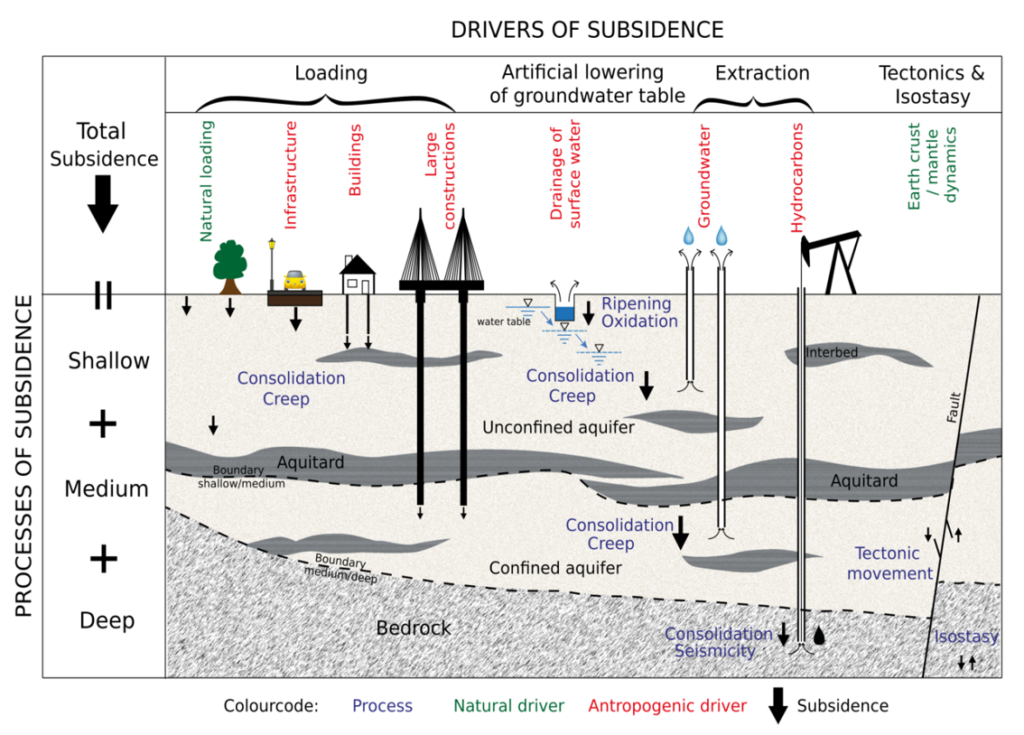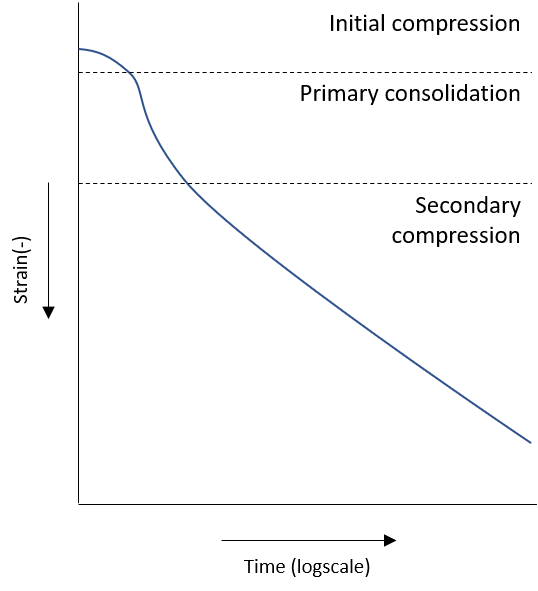WP2.2 – Understanding long term viscous and short term elastic soft soil deformation leading to land subsidence
Introduction
Land subsidence is one of the largest risks that many deltas around the world are facing. Two categories can be distinguished within land subsidence: Deep and shallow subsidence. Here deep concerns the consolidated part of the subsurface consisting of various types of rocks and shallow concerns the unconsolidated sediments like sand and clay (Figure 1). Since shallow land subsidence is most prominent in the soft sediments of the subsurface, like clay and peat, this PhD project focusses on these soil textures with peat as the main focus.

Figure 1: Drivers of subsidence and the depth at which these drivers act (Minderhoud et al., 2015).
The compaction of soils, which comprises the mainly physical components of subsidence, can be separated into three time components after an additional load is added on the soil (Figure 2):
Initial compression: The instantaneous compression of a sample.
Consolidation: The expulsion of porewater due to the increased pore pressure as a result of the additional load. This phase ends when the excess pore pressure has dissipated.
Viscous compression: The viscous movement of soil components due to the restructuring of the soil matrix under constant stress over time. This is commonly referred to as creep. An important detail to note is that the viscous movement of soil components already starts during consolidation, but becomes dominant in this phase.

Figure 2: Conceptual semilogarithmic time-strain diagram, divided into three phases of compaction (van Elderen, in preparation).
This PhD project tries to unravel the driving processes leading to creep in peat. Creep deformation in general has been studied in the past and as a result, the phenomenon can be modelled using several geotechnical parameters. However, why this phenomenon is occurring is still up for debate. Especially for peat and other organic deposits, very little is known about the driving processes. Acquiring more knowledge on these processes can help us to better model and predict the subsidence in the future. The newly acquired information hopefully also helps mitigating the consequences from creep deformation.
The first results of a literature review show that the known drivers of creep in clay, which are expulsion of micropore water, changes in the adsorbed water layer and changes in interparticle forces, also drive creep in peat. Additionally, peat decomposition is proposed as another driver of creep, unique to peat. This was determined based on the significant differences in material properties between clay and peat. Which of these drivers has the largest influence on creep in peat remains unknown. Due to heterogeneity of peat, this will vary likely. More laboratory experiments would be needed to affirm both the hypothesis on decomposition as one of the drivers as well as the exact influence of the different drivers. A next step in entangling peat heterogeneity on compaction or creep behaviour could be done with oedometer data.
Research topics
For the identification of the driving processes, first an overview has been created of the present knowledge on creep. The overview exposes the (largest) knowledge gaps on creep of peat. The next step to take is to zoom in on those knowledge gaps and, using existing and newly acquired laboratory data, try to fill in the missing information. After the identification phase, several subjects will be investigated for their influence on the creep phenomenon in sub-projects:
Clay-peat parameter dependency: Using existing oedometer data to see distinct differences in compaction behaviour between peat and clay. The goal is to couple descriptive parameters, like unit weight and water content, to geotechnical parameters that describe the compaction behaviour.
Dual porosity: The division of pores into macro- and micropores and the dynamics of water drainage during primary consolidation and secondary compression are the prime subjects of this project. CT scanning will be combined with oedometer testing to get visual confirmation of the current theory that deformation of micropores is on of the drivers of creep.
Peat decomposition: The anoxic decomposition of peat components and the structural change as result of the smaller or weaker components. The goal is explore the influence of peat decomposition on the strength of peat and the creep rate. Likewise, a possible relation between the compaction state of a peat sample and the decomposition rate is looked at.
This PhD projects links up with two other project within work package 2. A connection is made with WP2.1 on the sub-project of peat decomposition and the relation with compaction behaviour. Also, a link exists with WP2.5, for which relations/formulas found in the different sub-projects will be used as input for the subsidence model.
Staff
This PhD project started on the 13th of January, 2021 and is carried out by Pepijn van Elderen MSc. and is supervised by Esther Stouthamer, Gilles Erkens and Hans Middelkoop.
For questions or requests related to this project, please contact Pepijn van Elderen MSc. at p.vanelderen@uu.nl.
LinkedIn: https://nl.linkedin.com/in/pepijn-van-elderen-523b8b138

